
Tim Kennedy Jane and Rose 34″ x 48″ oil on linen
click here for a larger view
I pleased to present a telephone conversation I had recently with Tim Kennedy, a Bloomington, Indiana painter who teaches at Indiana University and shows at the First Street Gallery in NYC where he is currently having a solo exhibition (up until March 24, 2012) His gallery press release states:
… In this exhibition his focus is on the people of the area through portraits of neighbors and colleagues as well as paintings in the genres of interior, still life, townscape and figure composition. … “Tim Kennedy’s paintings fall solidly into the tradition of painterly American realism that prizes the particular and the empirical. They allow the viewer to examine the sharply experienced, yet ordinary event. The unspoken character at the center of the paintings is the connection of human relationships whether people are the primary subject or whether the subject consists of objects, interiors or landscape views. The paintings celebrate life experienced through the senses. Mr. Kennedy’s use of oil paint favors visceral color and the undisguised presence of the artist’s hand. This is work on a human scale that communicates direct experience with the subject and is filled with light and air.”
Larry Groff: You studied at Brooklyn College in the early eighties. Did you study with Lennart
Anderson, and if so, how much of an influence was he on you?
Tim Kennedy Well, I did study with Lennart, and he was a big influence. I don’t think,
necessarily that was the reason I had gone to Brooklyn, but he ended up being an
influential person. There were three people that had a big effect on me. Lennart, Paul
Gianfagna, who taught the anatomy class, and Joe Groell, who taught a very personal
history of design class. I had initially found out about Brooklyn when I was at
Skowhegan. Lois Dodd was one of the people teaching my first summer there. I actually
went to Skowhegan for two successive summers. I am the only person of my age I am
aware of that went to Skowhegan for more than one summer.
Anyway, at Brooklyn Lennart had a Saturday morning painting class that he taught from
the figure. My grad class at Brooklyn was a funny class – we were a little rebellious. I
actually ended up painting abstractly when I was there. That might be a bit of a
surprise…
LG: That is a surprise.
TK: Regardless, Lennart was very influential. He had this Saturday morning class
with the figure. I also went to a still life class he held for undergraduates during the week
a few times. So, when I went to his class I painted from life and got a great deal from it
as an experience. This is the only real painting class where you paint consistently from
the motif I have ever taken. My undergraduate experience at Carnegie-Mellon wasn’t like
that at all; it was more about assuming that nothing was known and it all had to be
reinvented – which was valuable in its own way.
LG: Was he supportive to your painting abstractly?
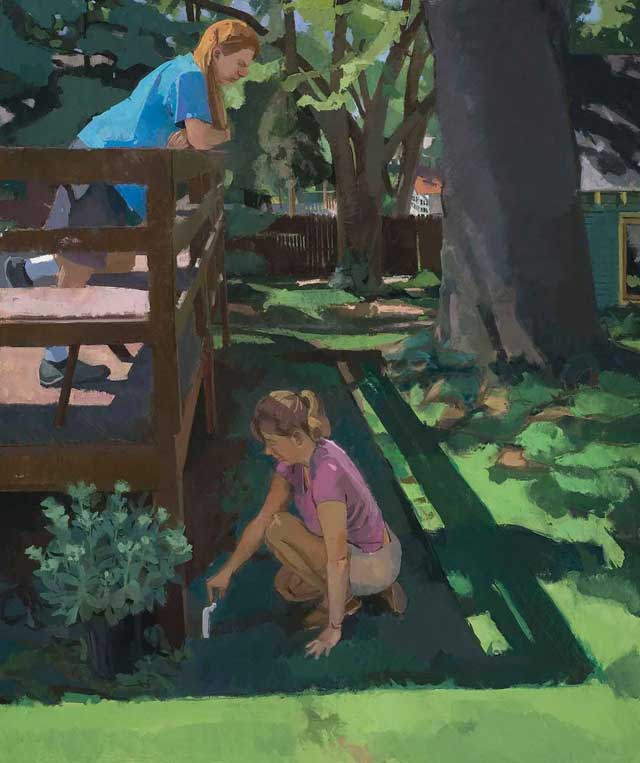
Planting 48″ x 40″ oil on linen
TK: Not really. But this was the time of Neo-Expressionism and I felt that I ought to be
doing something like that. I suppose I was a little disappointed with the type of reaction I
was getting to my modest paintings from life. As I said, it was a rebellious group that was
in there, and I think Lennart actually found it a little frustrating. With Lennart’s class the
idea was that you would be showing up and painting the model in a more or less
structured way—it was actually a new thing for me at that point, and it didn’t necessarily
come easily. He had good things to say, but I was totally unused to that as an
experience—somebody coming around telling you what you were doing wrong. I think
ultimately he would have been happy to work on my painting, but from my background at
Carnegie that was something that just wasn’t done. I was foolish – I was too precious
about my paintings. But, I mean, just even on the one occasion where he touched
something I was working on and he blurred a couple of edges, there was something
magic and healing about that.
In a sense his real influence came years later. A friend I
knew at Brooklyn turned me onto the book popular with Lennart’s students, Hawthorne
on Painting. That is a book that has only become more influential for me with time.
The thing that was really interesting during that first semester were the ways he would
teach us how to look at other artists and how to look at the motif. He would bring books
to class on Corot, Ingres and Morandi and talk about the things he saw in them. There
were shows of Edwin Dickinson, at Hirschl & Adler Modern at that time that were
extremely influential. He helped me understand what was going on in Dickinson’s
paintings.
But he got a Guggenheim during the second semester of that year and was going to take
the year off. As a group we felt a bit shortchanged so we talked him into continuing to
come on Saturdays to paint along side us. It was really valuable to watch him paint.
I went to Italy the summer after grad school, and I painted landscapes there. I painted
portraits of a bunch of students that were at a printmaking school there too. That was
when a lot of the things that Lennart would talk about and the things that were discussed
in the Hawthorne book kicked in.
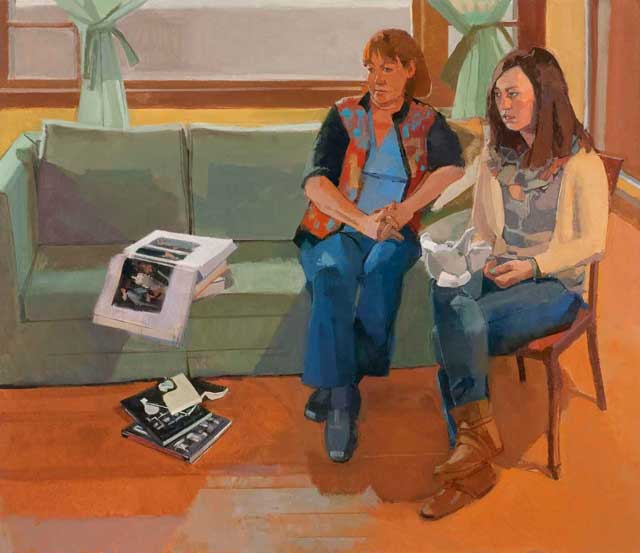
Lauren and Brenda (with Babar) 48″ x 56″ oil on linen
LG: What school was this again? I missed what school it was.
TK: It’s a place called Studio Camnitzer, and it’s outside of Lucca. It was actually run
by the conceptual artist Luis Camnitzer.
LG: Is it still in existence?
TK: Yes, as far as I know. But anyway, I helped David Finkbiner, who taught there, fix
up a house that he had bought, – I wasn’t even actually part of the school.
LG: There appears to be a remarkable directness and freshness to your paintings.
They are carefully drawn, observed, and resolved with very specific tones. Is this
something that comes easy for you? How much of a struggle goes on behind the scenes
with your work?
TK: The artist always sees the imperfections in things. But I think from early on, I was
able to get a likeness when I drew, and I did watercolors in high school. Watercolor was
the way I was introduced to painting. I don’t even know how to answer this exactly. I think
it’s something that developed over time. Initially, when I began painting, this ability to get
resemblances — if anything, I was a little suspicious of it, and the idea of a high finish.
When I was in undergraduate school, particularly, the kinds of things I admired were a
little rough. I mean, I admired Abstract Expressionist painting. I admired Dada. I admired
Pop Art. I liked people like Morandi and Diebenkorn and Porter. The idea of finish—I
wasn’t sure whether that was the kind of thing that I should be trying to achieve.
I don’t think that I’ve ever felt that I fit comfortably into other people’s expectations in
relation to this stuff, either. And who knows, exactly, what those expectations are. It’s a
funny thing in terms of the art world. The interest, I think, in the kind of painterly painting
that you celebrate through your blog, and the kind of thing that I’m interested in is
something that kind of expands and shrinks in terms of interest over time. There seemed
to be a surge of interest around ten years ago. I think it has shrunk a little bit since, but
maybe it is growing again, particularly through the kinds of things that you are doing and
Catherine Kehoe is doing.
LG: There definitely seems to be wide interest in perceptual painting. I think more and more people are becoming attracted to painting, especially people with more available time like those
starting to think about retirement or whose kids have left home. Maybe with the economy
they’re laid off, can’t find work, so they think, ‘I might as well do what I want.’ For any
number of different reasons people, I think, are more interested in learning how to paint.
But sadly, I think, they’re being sucked into thinking painting is more about the subject
matter itself, copying photographs and other less helpful directions artistically. Many people who want to learn how to paint realistically are much concerned with learning techniques. Ateliers, workshops, magazines, DVDs, etc. teaching the
secrets and techniques of so-called “Old Masters” have become far more visible than in years
past. What is your take on the popularity of learning technique? Do you think having a
good technique leads to better painting?
TK: I’m not certain. I don’t think they could hurt that much, but I think probably people
should be cautious not to get stuck in it. I think in an interesting way that people develop
their own techniques by whatever the painting is calling them to do. Eve and I, obviously,
we’re partners and we’ve lived together. I really like watching her paint, but I wouldn’t say
that I have a technique when I paint, and I wouldn’t say that she necessarily has a
technique herself. Basically we both just do stuff until it works – a lot of making and
unmaking. I’ve heard of really elaborate descriptions of how Scott Noel paints from
former students of his. Have you talked to Scott?
LG: I haven’t talked to him, but I’m familiar with his work, and I know people who have
studied with him.
TK: And I don’t know how strict he is about doing this anymore, but I think he had a
real group of things that he would do that were real interesting. He would apparently lay
in everything with a palette knife, and specifically use Cremnitz white. And then
apparently, when he had things laid in he would take a large paintbrush and essentially
stipple it to blur everything out, and then he would work back into it. Which sounds like
an interesting thing, and you can kind of see it in the paintings. And again, that’s sort of a
Dickinson idea, I think.
When we were at graduate school, actually, there were techniques classes that we
would take. Philip Pearlstein and Paul Gianfagna and I think Joe Groell, too—they all
taught technique classes, and usually it was a history of techniques class. And Philip’s
class was a little perfunctory in the sense that it was more about the ideas that
surrounded different periods of history. He was interested in it enough to be able to
discuss ideas that came up at different points in history. But in Paul’s class you actually
learned how to do tempera painting. And that was an interesting thing.
And part of it was ideas about scumbling and glazing. And it really worked: the glazes
were darker colors that were going over lighter colors. This is the theory of Cennino
Cennini—that this is always going to be inherently warm, and then the scumbles, which
would be the lighter color over a darker color, were always going to be inherently cool –
no matter what the actual color. It sounds fishy, but it’s really true.
And the weird thing is I can see it in painters like Veronese in lots of places. You can
see it in somebody like Vuillard. It’s not a specific technique, but it is a powerful idea that
can be embedded in paintings and I think it is something that is really active – which
makes it interesting to me. This is actually an idea that I try to use when I paint.
LG: That certainly makes sense. I guess, in terms of my question, it makes sense
coming from when we were in school, back in the eighties or even in the nineties—that,
that was the kind of technique that was taught. It was taught in a much broader manner
and a more open sense, whereas today a lot of times you see technique—at least not
coming from the universities, but more from the ateliers and magazines that emphasis
things like the rules or steps needed to properly paint a certain subject.
TK: No, I can see that. Like I say, sometimes I can think of it as kind of good and then
other times I think, Oh, gee, I don’t know if I like that so much.
LG: Like the people who want you to learn how to paint like Bouguereau or
similar—more academic approaches. An impressive level of skill that they’re after in
terms of drawing and painting ability. Don’t get me wrong. I just think there’s so many
people hung up with perfecting technique that they put off whatever their reason to paint
to begin was perhaps. They sort of figure, Well, I’ll figure that out once I learn all the
technical aspects first. When I can draw and paint good enough; then I’ll figure out what
it is I want to paint about. It doesn’t always seem to work out that way.
TK: Yes, I agree with you. I guess I tend to like the idea of a painting developing in an
active way. I don’t know. Maybe it’s something out of the Studio School or maybe it’s
something out of Hans Hofmann. It is a more constructed attitude toward a painting and
that is appealing to me. Although, I don’t want to pooh-pooh the other approach,
completely. I am sure there are things to learn from a technique driven approach, but the
structures beneath technique interest me more.
I’m teaching an anatomy class these days, and that’s an interesting thing, just in general.
First of all, it was valuable when I took it in graduate school, and that was, again, an
eye-opening thing – that there was something outside of you in the world that was real,
that you had to measure up to in a particular way—and that it influenced how you looked
at the things in the world, whether it was the figure or objects — and that they had some
sort of inherent form that you had to decode.
And again, these structural things are useful, I think. The more technical things such as
the way that you hold your brush or the order that you put down your color or how you
hold your pencil are less important to me. I guess what I am saying, is for myself , when I
work, that it is almost never the same twice.
LG: I can certainly understand. When I was in school, it was really hard to get that kind
of information, and…
TK: It’s true, it’s true. You’re right. But that’s exactly the experience that was at
Carnegie. And I got very valuable things at Carnegie. I thought that the other students
there were very talented, and you sort of made stuff up as you went. And actually the
teacher I had there—a wonderful person and influential person for me and a friend,
David Schirm—he just was not interested in telling you about stuff like that; so, you sort
of reinvented the wheel in a weird way.
And again, in an odd way, truthfully most of the stuff that I discovered in terms of painting
from the world and painting from objects were things that I did on my own. As a matter of
fact, there were a bunch of instructional books. I read a book called Art and Reality by
Joyce Cary who was a novelist, and that was a really interesting book to me. There were
a couple of books by an English artist by the name of Bernard Dunstan, who would tell
you practical things in a lot of ways, but it wasn’t open and closed kind of technique
advice. It was about tendencies that he applied in relation to how he might look at a
composition or how he might put together a still life.
There was a problem I remember he had (I actually did this out of his book). It was the
idea that you might collect a bunch of similarly colored things and scatter them across
the floor and paint them. Then you would find out, actually, how different the colors were.
So anyway, that was the extent of my technique, as it goes.

Badminton 48″ x 40″ oil on linen
LG: I think some of the most interesting painters are the ones who figured out, on their
own, what painting they wanted to paint. What painting was theirs. That, that was a really
big part of the subject matter, was how to take the familiar theme, but to make it theirs
somehow.
TK: There’s truth in that. There’s definitely truth in that. I mean, one of the things that’s
actually quite interesting is to see how Rackstraw Downes’s paintings developed over
time. Some of the first ones he did in the seventies—they look more like Neal Welliver
than Fairfield Porter because they weren’t quite as organic looking. But he gradually
built up a way of painting where he could do more and more things. But I don’t know that
anybody really told him how to do that.
LG: He doesn’t seem like he comes from any kind of place other than just responding
to nature, really. He just sort of decided on an aesthetic basis that he wanted to paint the
world as he saw it, and that, that was good enough. That you didn’t need to editorialize
as much as some people say you have to.
It interests me a great deal—the idea that total concentration on painting what you see
and how this can actually help you to become more self-expressive, more honest than if
painted through some notion of making high art. Going after a style and imposing your
will on the scene in order to “make art” often paradoxically winds up being less art and
more artifice. Sometimes you can better find your true voice by turning down the volume
of your conscious brain.
“You must forget all your theories, all your ideas before the subject. What part of these is really
your own will be expressed in your expression of the emotion awakened in you by the subject.”
– Henri Matisse
TK: These are all kind of very familiar attitudes to me. I mean, I agree with them. And
again, I think that maybe some more current ways of going into this—these are not the
things that people are assuming—but I totally identify with the kinds of things that you’re
saying. Again, early things that I was reading and interested in when I started painting
from the subject…I thought the critical writing of Fairfield Porter was really interesting
stuff, and it sounds very much like a lot of the attitudes that you’re referring to. They seem
to be very much a part of that attitude. The idea of not imposing yourself too much,
certainly, was a big thing. And I guess I still very much represent that as an idea in what I
am trying to do. I don’t know that people automatically understand where I’m coming from
with it anymore.
LG: Right. So many people think that by doing that, you’re copying nature. That
somehow it’s a lesser activity. That it’s just, “Oh, you’re just copying nature.”
TK: I suppose that, that is part of the attitude. I mean, it wasn’t at the time when I was
first exposed to these ways of doing things. It was not just the painting at that time that
reflected these attitudes. I think that you can see it in movies from the time too. Eve and I
watched Nashville, the Robert Altman movie recently. And there’s so little that’s imposed
onto the movie, it almost feels like things are just happening. That would be unusual to
see in a film now. Now it’s just all fast cutting and car chases and blood.
LG: Well, Nashville was a little more exciting than, like, say Warhol’s Empire State
Building or something.
TK: (laughs) I guess I never made it to the end of that one.
LG: You’re right. It’s funny, sometimes it seems as soon as you start to make a rule, or
some sort of belief system, then you find ten other things that contradict it and makes it
look ridiculous.
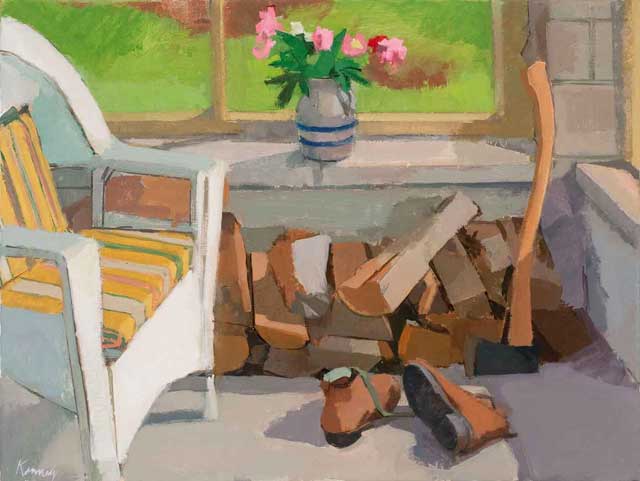
Peonies 18″ x 24″ oil on linen
LG: In your interview with Maureen Mullarkey you discussed the pros
and cons of your moving away from NYC to Indiana when you said:
“On the other hand there were unspoken limitations and constraints on what I would paint and not paint when I lived there. And I feel that those are completely gone now. I paint the interior of my house, my yard, town landscapes and pose models in situations that somehow mirror my life here. In a sense I have a life to paint…”
Paradoxically, you later said how living
outside NYC can have a downside when: “groups of people out here can be more
censorious of things that aren’t hip.”
Many readers of this blog might seem to be working underground in a “painting ghetto”,
as you said: “The painting world is a kind of ghetto—but ghettos can be very vital
places“. I’ve heard painters complain of working in isolation and of rejections by local art
venues because work from observation seemed academic, conservative and unfashionable while at the same time snubbed by traditionalist, plein-air type venues who see their work as being too crude or modern. Is there any hope for a solution to this conundrum? What solace can you offer from the heartland?
TK: First of all, I think coming out here, it’s actually been a really good thing. In
Maureen’s interview, I say something like “having a life to paint.” And I do feel like
there’s a bigger range of subjects, and things that I might not have painted while I was in
New York. But the way that you’re phrasing it—that people are very
technique-driven—they don’t understand completely where a sensibility like mine is
coming from, and in the sense that they do see it as a little crude.
And then other people that are maybe doing completely different kinds of things in art,
whether it’s an installation or something like that, they would see the kinds of things that
I’m interested in as being very tradition-bound. And it is hard to find a place for yourself in
that way. It’s not impossible. I mean, there have been some nice situations here. There
was a gallery run by Mark Ruschman in Indianapolis that unfortunately closed and there
were several people there that painted from an empirical sense of things.
One of the places that seems the friendliest to this kind of sensibility is Philadelphia.
There are people that surround the Academy and actually a lot of art students that are
particularly interested in this approach to working have gone there.
LG: The Gross McLeaf gallery is a great venue for this.
TK: Yes. That’s a place, certainly, where a lot of people have shown up. And then
there’s a couple of others, too. There’s a student of ours, Chris Fiero, who is currently
having a show at a place called Rosenfeld, that’s part of that sensibility as well.
I do think it’s actually survived in Boston, quite a bit. Maybe it’s that some of the
mid-sized cities that are not New York have a level of culture to begin with and a kind of
tradition that already exists. And certainly, when you do run into individual artists, they’ve
existed in these places for a period of time. I mean, George Nick is certainly a great
example of that. He’s a wonderful painter. Also, Barney Rubenstein, who is no longer
living, was a great figure from Boston and Catherine Kehoe practices there now. So a
tradition carries on.
LG: And there’s a number of great galleries there…
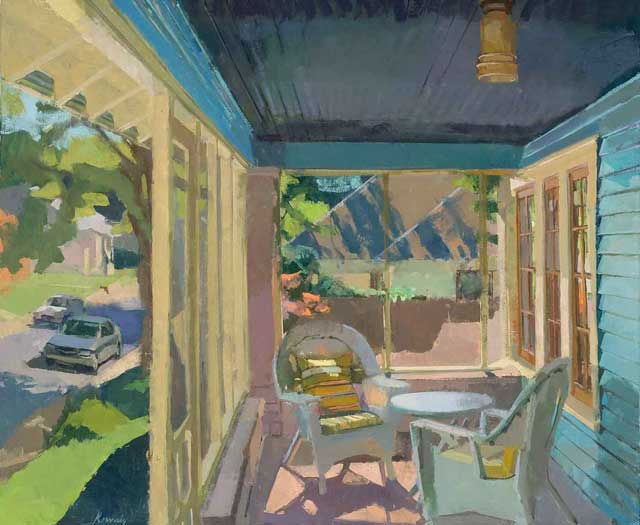
September Porch 28″ x 34″ oil on linen
1003 8″ x 10″ oil on muslin panel
TK: And actually this is something from the time that you were maybe at BU. Did you
know a person by the name of Jonathan Imber?
LG: yes.
TK: I lived in Boston for a while. I thought that was a really interesting painting town.
LG: Sure…
TK: And also from BU—you wouldn’t have met him personally—but I’m sure his
presence was really felt there, was Philip Guston
LG: Definitely. There was a lot of that influence. Also Walter Murch was there for
awhile.
TK: I didn’t realize that. And he’s somebody whose paintings I’ve always admired.
He’s sort of a treasured, unknown person. Boy, talk about somebody that has just this
great way of seeing. I don’t know that there’s any particular technique. It’s just sort of an
invented technique. I mean, in a weird way some of those paintings that he did in the
forties and the fifties, they seem to begin like Jackson Pollock paintings.
LG: Well, he was very close to many of the abstract expressionists, and studied with
Arshile Gorky.
TK: I did not know that. That’s really interesting, because I don’t know much about
him.
LG: I have a whole big post on him on the blog… (Link to Walter Murch article) I actually scanned in a whole catalog of his
paintings. There’s a very rare catalogue from the Rhode Island School of Design. They
had a big retrospective back in the early sixties. And I was lucky to get that book a long
time ago when I was in Boston. I found it and snagged it. I figured it was out of print like
ages ago, so I wanted [it]. People have heard of him, but then you can’t find his work, or
you used to not be able to find the work. But now you can.
TK: It’s like a hidden history.
LG: Well, there’s so many painters like that. And that was part of my motivation for
starting the blog was to let people be aware of all these people like George Nick who
were great painters. Who if you’re not already connected to a school or a big city, you’re
likely never to hear of, and never be able to get any influence from. So, I really felt like
there was a need for that. And that’s a big consideration with this question.
There are all these people in all these cities that are painting, some of them self-taught
or they just take workshops, or any number of different ways, but it seems like there’s a
basic human need or drive, artistically, to want to paint the world in which we live, and I
think there needs to be reinforcement that there’s nothing wrong with that. That so much
of the art world has dismissed that as being unimportant or somehow lesser than
painting about grand ideas or historical events or whatever. But just simply painting
some flowers or a couple of friends sitting on a couch can have great visual power and
that people should be supportive.
Not to say that you’re going to make some clichéd thing that people have seen a million
times before…
TK: Well, I agree. Back to your earlier question about technique, I suppose that’s why
I wouldn’t rely on technique too much. I think you want to go into it with a pure heart – the
idea is that if you are genuinely experiencing the things around you, I mean, it is a new
experience. I don’t know. Maybe I’m not phrasing that very well.
LG: It is. I know what you mean.
TK: You’re seeing through an individual filter. You’re seeing the world new. And to tell
you the truth, for people maybe complaining and saying, “Well, we’ve seen this
before…” In a weird way, I don’t think there’s any real progress in art. And things are
different enough, in a weird way. Fairfield Porter idealized Vuillard but he ended up
doing something very different from him, just through being who he was. Just being
American. Seeing an American landscape. Experiencing American life. There are so
many things I admire about Porter, but hopefully I’m doing something a little differently
than what he was doing, as well, and I suppose that’s how things get carried on.
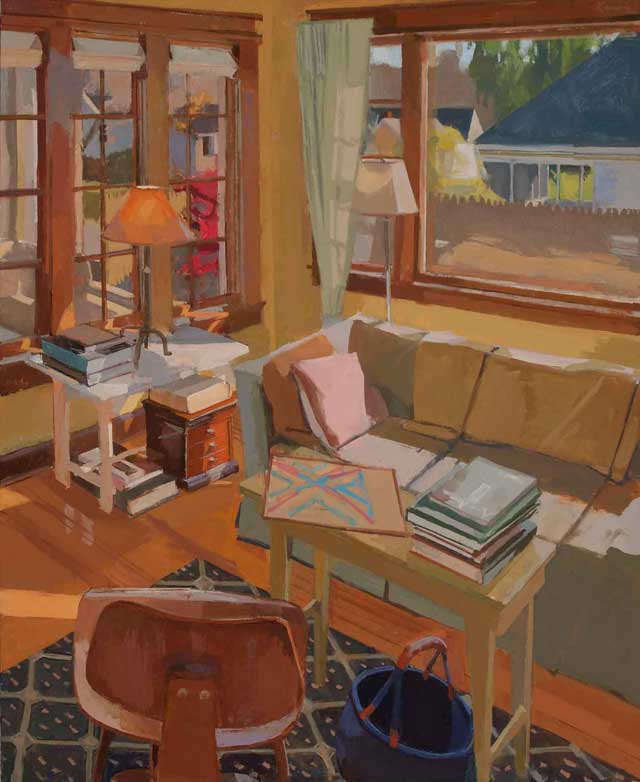
Interior With Game Board 34″ x 28″ oil on linen

Daisies and Bentwood Chair 20″ x 16″ oil on muslin panel
LG: Your paintings appear to celebrate joyfulness, beauty and simplicity. George Nick
once asked, “How can anybody paint unless they’re happy?” Would you say you’re a
happy person? How important is your mood to the success of your work? And is being
happy enough for a painter?
TK: [Laughing] Actually, I’m probably a little depressive, and I’ve been a little
depressive for most of my life in an odd kind of way. So, I don’t know. There’s a little Irish
darkness or something like that, which is sort of the way my family was. Not that we were
all that self-identifying as Irish or anything.
I was thinking about this. I think, if anything, I don’t necessarily have to be in a good
mood to be painting, and if anything, maybe if I’m sort of in a dark place, but, once I start,
I think the idea is maybe you work through that, and that something joyful comes out of it.
But, it has its complexity. And to tell you the truth, even a figure like Porter, if you ever
read that Justin Spring book…
LG: I did…
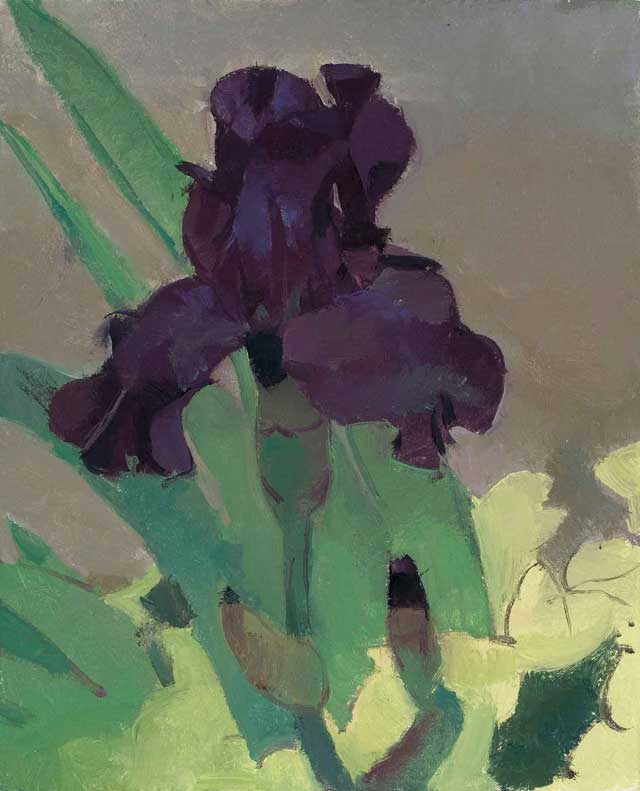
Iris 10″ x 8″ oil on muslin panel
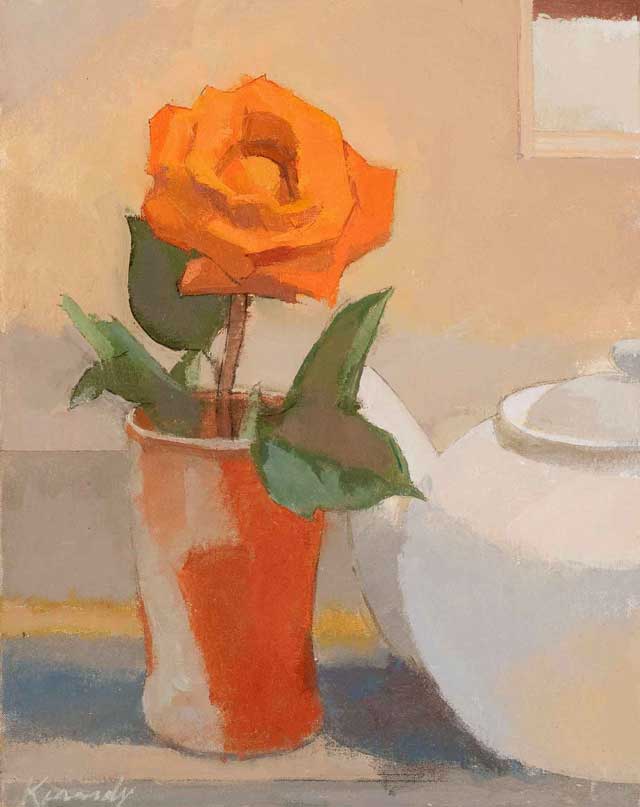
Rose and Teapot 10″ x 8″ oil on muslin panel
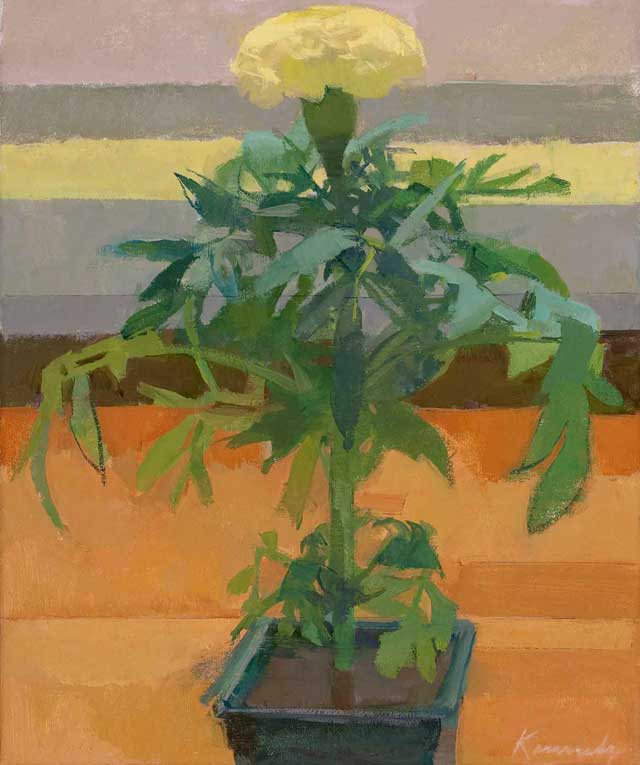
Marigold 12″ x 10″ oil on linen
TK: Actually, he’s a pretty complicated person. There were many troubled and
troubling things about him, and I don’t think he had an easy time of it. Eve stopped
reading that book because she didn’t want to know about it. But I can identify with a lot of
that stuff. And I think that if anything, maybe that’s the point, that maybe you want to be
the “happy warrior.” That you deal with the surface of things and you deal with what is
necessary in life, and you persevere, regardless of difficulty, and so that it appears easy.
There’s a quote by Matisse. I don’t know where I got this from. Somebody had asked
whether he believed in God, and he said, “Well, I do when I’m painting.”
LG: There you go.
TK: And Scott Noel actually uses a terrific quote from Nietzsche as an introduction for
something that he had written. It’s about the Greeks and profundity, because they
stopped at the surface. They believed in appearances. There is something profound
about that. I think it’s more complex and more interesting than people give it credit for.
“Oh, those Greeks! They understood how to live. What you need for that is to be brave and stop
at the surface, the fold, the skin, to worship appearance, to believe in forms, tones, words the
whole Olympus of appearance. Those Greeks were superficial – out of profundity… “
–Friedrich Nietzsche
The other thing is I also think you have to know about something to see it. The people
that really understand paintings are people that have also painted. The frustrating thing
is the people that are frequently writers—which a lot of people in the museum and the
exhibiting world are—give this other way of seeing things sort of short shrift, because it
isn’t a written thing. At its heart painting is a wordless experience.
LG: Absolutely. It’s about feeling. It’s about visual feelings, in a way…
TK: Oh, very much. Very much.
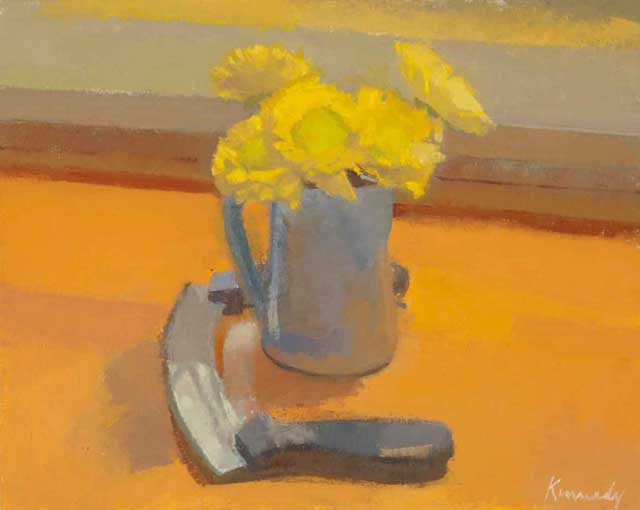
Mezzaluna 8″ x 10″ oil on muslin panel
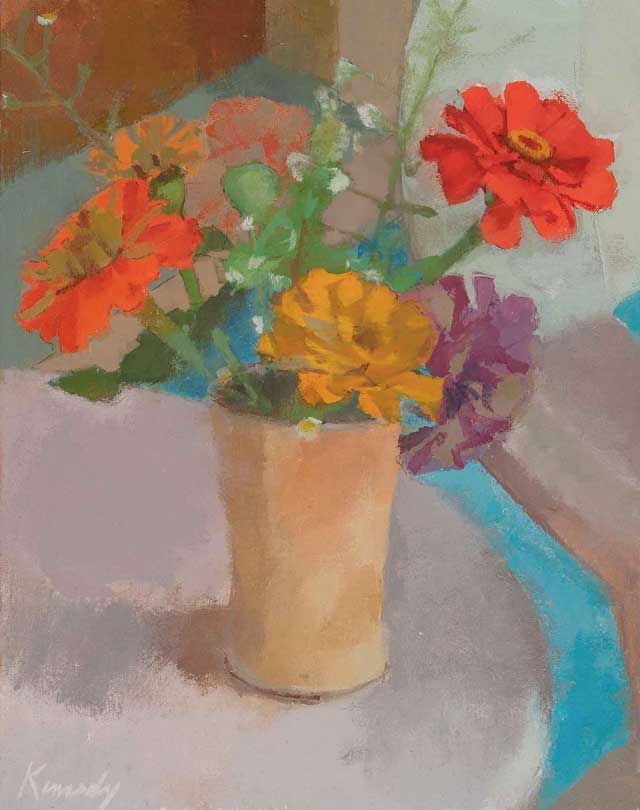
Late Summer Zinnias 10″ x 8″ oil on muslin panel
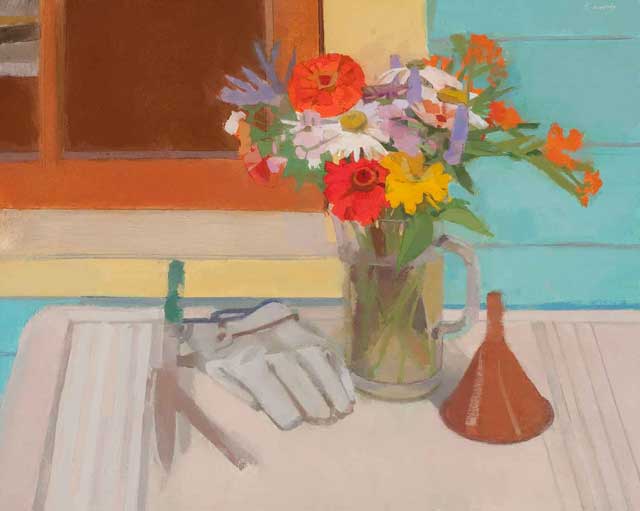
Summer Flowers 16″ x 20″ oil on muslin panel
LG: …it’s almost impossible to write about. So they write about your subject matter…
TK: This is exactly true. People do write about the subject matter, and that is the thing
that comes across in something like a press release or something. Which again, it’s a
shame. I think that people are missing the point. Truthfully, people are robbing
themselves of a pleasure. It isn’t the things in the painting that are the important thing.
LG: Is that why the title of your show in New York is called “Appearances?”
TK: Yes.
LG: What are your thoughts on that title? Does that have any relationship…
TK: The Nietzsche quote has been on my mind, and truthfully, appearance is what is
available to you concerning the world. It is also a bit of a pun in the sense that here are
these people walking in and out of where I’m painting, and they’re making an
appearance. I guess it was both ideas.
But again, the information that you get from the world is through what you can glean from
its surface, and you have to infer a lot of things. It’s a bit of a detective story in a weird
way, just even interpreting what you’re seeing light wise. Which is interesting.
Essentially, you’re watching how light falls on things. And sometimes it takes a long
period of time to see what actually is happening, whatever it is that you’re looking at. You
define the subject by being out there for hours at a time. And you learn something about
it. It’s intriguing.
LG: Right. For me, your paintings may start off in a dark place, but it ends up being
very light-filled and joyous to look at. You must at least be very happy when you finish
the painting. Your painting must be a transforming experience for you. Here’s the world
as I saw it, or perhaps even a record of my evolution of feelings about it.
TK: Well, I would hope so, certainly. Again, a controversial quotation by Matisse is
that quote about the armchair.
“Art should be something like a good armchair in which to rest from physical
fatigue. “
But I think that the idea is that the painting would be a place of respite or a place of
refuge or a place of solace for a person after they’ve spent a day encountering the world.
And people will sometimes look at that attitude askance because there’s a feeling that it
would be escapist. I suppose that would be the criticism of it. But, you know, life is hard
enough. I think that people are entitled to this kind of pleasure. And it’s the kind of
pleasure that actually demands a certain kind of discipline to be able to even understand
it.
LG: You certainly do a fantastic job with it. Thank you for taking the time and energy to do this interview.
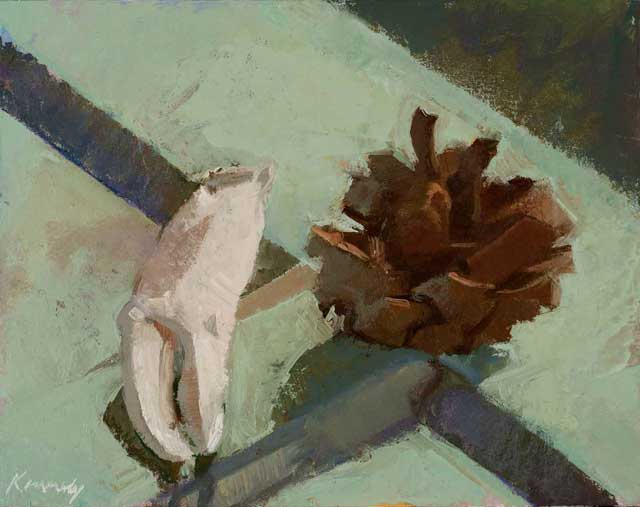
Claw and Cone 6″ x 8″ oil on muslin panel
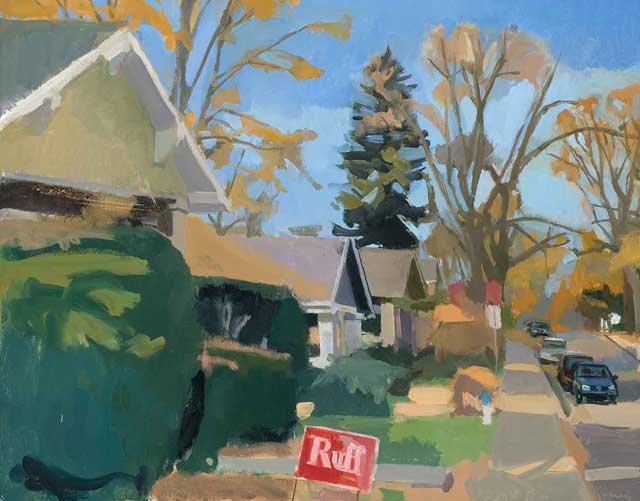
Ruff for Council 22″ x 28″ oil on canvas
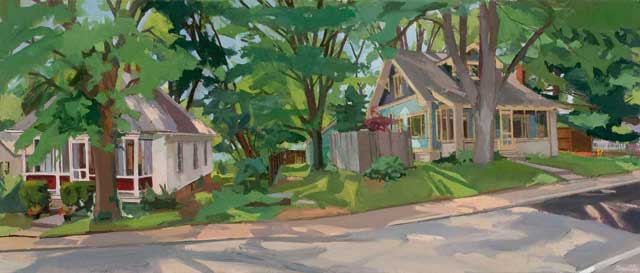
On Lincoln Street 18″ x 42″ oil on linen

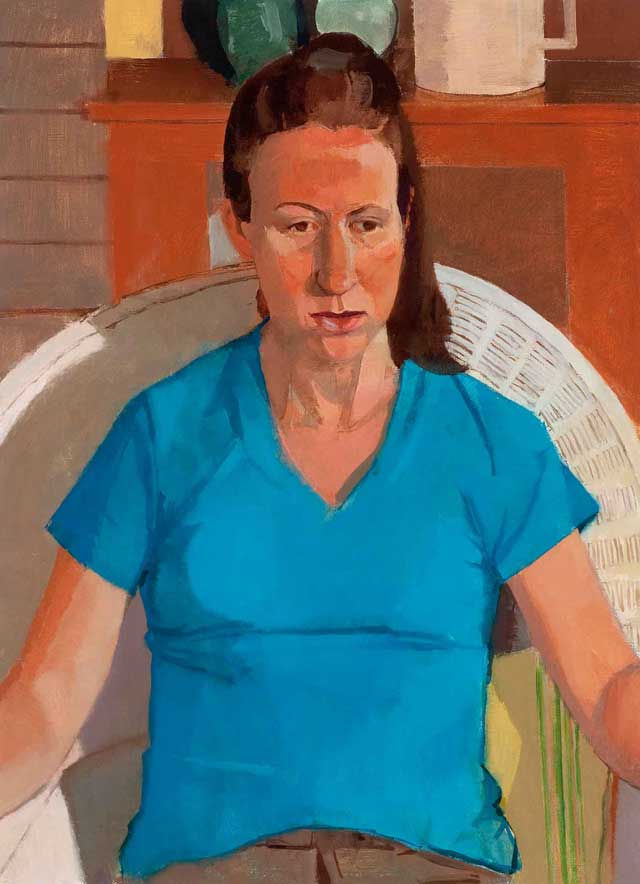
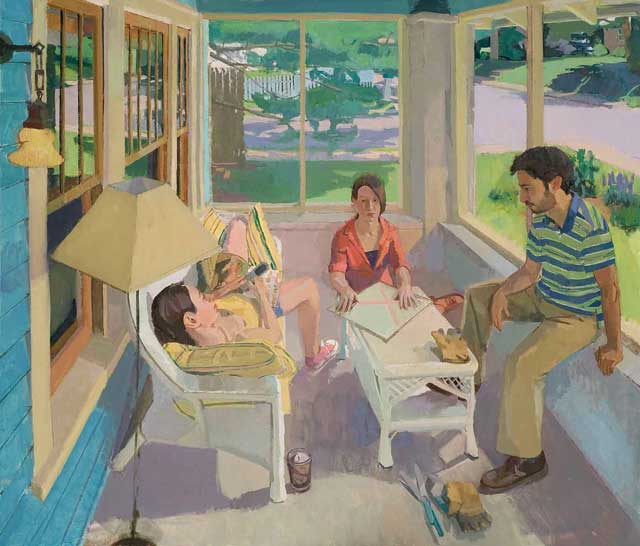
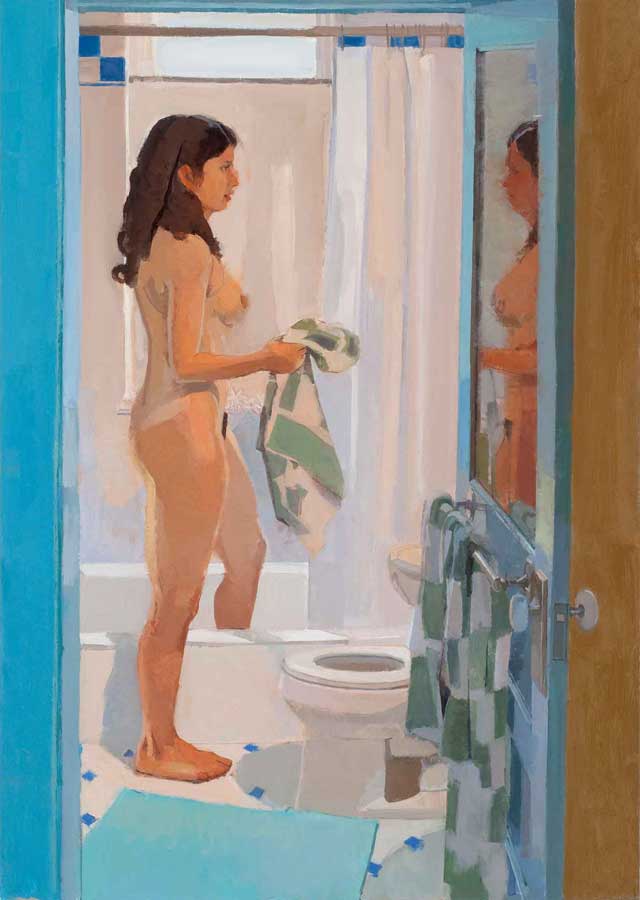





Brilliant interview and brilliant painting! Thank you both.
Just beautiful paintings with gorgeous edges and wonderful use of color. I want the marigold! Hope I can get to NY and see your exhibit Tim.
Thank you so much for this interview – in many ways this distills the experience I had studying with Tim and Eve at IU. I haven’t thanked them enough for what they did for me as a painter. And perhaps I’ve underestimated how much influence they actually have had on me; so many of these sentences I’ve said to my own students. One of my main cherished memories from grad school was Tim working alongside me on a painting for a couple hours. I felt like it opened up worlds to me. Thanks to Tim, and thanks to PP for seeking out this sort of painting for focus.
A rewarding interview!
Thank you for this great website, Larry. I’m just beginning to go back through all the interviews and I’m finding them very informative, inspiriting, and comforting. I’ve been somewhat dismayed by what I’ve seen of the new “old master” paintings:
The technical proficiency is often very impressive and something I could never achieve – even if I wanted to – but my overall feeling is of an oppressive burnt umber atmosphere, the sludgy old academy back on its feet in all those “ateliers”… So I love seeing these modern, perceptual paintings like those of Tim Kennedy, full of light and energy and fresh perception! Thanks for the great painting, Tim, and thanks for the great interview, Larry!
Bravo Tim !!! I just wanted you to know that I found much to enjoy in the exchange between you and Larry Groff. I guess what heartened me the most was the consonance between what you expressed verbally and the visual correlations I was able to make within the work itself.
Greetings and warm regards to both you and Eve from Alto Adige !!!
Larry you never disappoint! Thank you both. Gorgeous paintings Tim! What an intelligent, thoughtful interview. Our generation of modern figurative painters interests me to no end!! So many painters feeling the same thing from so many places at once. I think there is certainly a grass roots movement developing here, maybe the first significant, lasting painting movement to seep out of a decentralized art world? I was in Manhattan a few weeks ago to see the Biennial and visit galleries and museums, and I came away feeling like New York painting, particularly the post-minimalist and surrealist-inspired figurative expressionism that is choking Chelsea right now, is more provincial than it has ever been in the past. Only a smattering of galleries in SOHO, Chelsea and midtown are showing figurative painters at all. I came away from NY with a renewed belief in what I am doing as a painter, and have realized that it just doesn’t matter one bit what the trends are in that city any more. The key for all of us contemporary modern figurative painters is to join together in community and make things happen on our own wherever we find ourselves. I think more and more people are wanting simple, authentic, direct experiences in our time of hyper-mediation. The Whitney Biennial was absolutely exhausting! I almost left the building in tears. As “perceptual painters” it’s like we’re all appropriating from what was great about modern figurative painting, and by doing so moving past the narrowly defined version of modern painting as it has been theorized by Krauss, Foster and other language-based interpreters of the visual. Post-minimalism!? Give me a break!! Reading this interview with Tim Kennedy is so heartening! Thank you Tim, and thank you so much Larry for all that you have done and are doing to pull together this very special community of painters. It means so much to me to visit your blog.
Sincerely,
Noel
Wonderful paintings and interview. Hello also to Tim Heins, a Brooklyn College friend; and Paul Gianfagna, a great teacher of Anatomical Drawing.
Hi Mike Boyle,
It’s nice to know that the Brooklyn College “fraternity” still lives out there. I treasure that wonderful portrait you did of me at Brooklyn College. Also have a great circa 86′”abstract” Tim Kennedy in my living room, as well as a few “figurative” works. Tim Kennedy’s painting is inspiring and knowing him at Skowhegan and later at Brooklyn College made me a better painter. Tim’s work is of the highest caliber and adds to a tradition of painting that will always be relevant.
Tim Heins
Wow! I’m so happy to have found this website. I have an 8 month old baby daughter and have not painted for over a year (although I am starting to draw again during nap time). There is so much inspiration to be found here. I appreciate the straight-forward, honest language used by both interviewer and artist – something that my own grad school experience did not encourage! I was the only painter in the group…but that’s another story. Anyway, thank you Larry for creating this venue, and thank you for introducing me to Tim’s paintings!
Gabriella Soraci
As one of those people who is somewhat isolated outside of the cultural support system offered in larger cities I really enjoy these interviews (or conversations) about painting. Lots of great points in this one. Thank you.